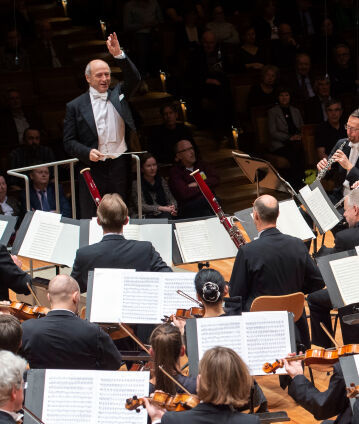“Guardians of Unity”: Conductors in conversation

The art of conducting has always been shrouded in mystery. In this film, Simon Halsey, who has worked closely with the Berliner Philharmoniker for many years as conductor of the Berlin Rundfunkchor, interviews renowned conductors about their views of this unique profession, the secret of good baton technique and the relationship between analysis and emotion when working with the masterpieces of music.
The art of conducting is something that is no easier to explain than the concept of charisma or aura. It reveals itself in the most subtle of feedback processes with the orchestra’s musicians. In contrast to instrumentalists, questions about technique and craft are also difficult to answer. So it is no surprise that the image of the “maestro” continues to be one of the most intriguing phenomena in the world of classical music. Since the orchestra was founded, the Berliner Philharmoniker have worked together with the most important conductors, and they continue today to convey a colourful image of the most diverse interpretation and conducting styles with their musical director and renowned guest conductors from around the world.
Simon Halsey has worked closely together with Sir Simon for many years and witnessed at first hand many of the Berliner Philharmoniker’s rehearsal processes when he was chief conductor of the Berlin Rundfunkchor between 2001–2015. In a series of interviews, he has spoken to the conducting magicians of our time about their careers, their significant teachers, and the methods they employ for their analytical and emotional understanding of a score. There are also questions about the best baton technique and the balance of authority and collegiality when working with the orchestra. Among those interviewed are: Sir Simon Rattle and his teacher and mentor John Carewe; Zubin Mehta and Iván Fischer, who have been giving concerts with the Philharmoniker for decades; Paavo Järvi, whose Beethoven recordings are regarded as revolutionary; Andris Nelsons, a conductor of the younger generation who, in just a few years, has performed a broad repertoire with the orchestra, and Louis Langrée, who Halsey interviewed at the time of his debut with the Philharmoniker.
A film by Benedikt von Bernstorff and Jakob von Bernstorff (2016)
Categories
Artists
© 2016 Berlin Phil Media GmbH
Our recommendations
- The Berliner Philharmoniker and Frank Peter Zimmermann
- Anton Bruckner and the Berliner Philharmoniker – conductors in conversation
- A magical beginning: The Easter Festival in Baden-Baden
- Philipp Bohnen: a portrait
- Sarah Willis: a portrait
- Cathedrals of Culture – Wim Wenders’s film portrait of the Philharmonie